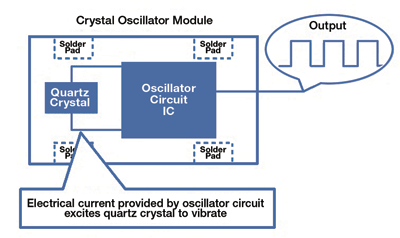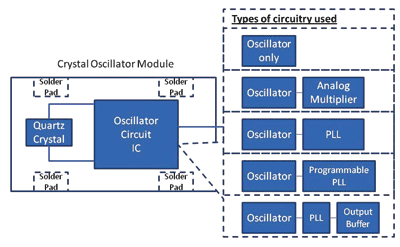How innovative changes have enabled us to develop the high-frequency systems that proliferate throughout our world
BY MING HOONG CHONG
Product Marketing Manager Timing Business Unit
Pericom
www.pericom.com
In many ways, electronic products resemble living organisms. For example, they have a central brain that might be a very simple 8-bit MCU or an extremely complex, multicore SoC. Their circulatory system flows with electric charge rather than liquid, and enclosures provide a skeletal structure for support and protection. They even have a heartbeat, typically driven by a crystal or crystal oscillator. Although often overlooked during design, these timing sources are critical for the reliable operation of electronic devices. In this article, we’ll explore the evolution of quartz timing technology across the years and how innovative changes have enabled us to develop the high-frequency systems that proliferate throughout our world too.
Quartz: The natural choice
Quartz crystals are able to generate consistent clock signals because of their good piezoelectric properties. Depending upon how a quartz crystal is mechanically manipulated, it will have a well-defined natural frequency to which it will oscillate when an electrical pulse is passed through the crystal. The stability of vibration that an excited quartz crystal is capable of maintaining is what makes quartz such a good timing source.
For these reasons and others, quartz-based crystals have been the preferred timing source of choice for watches and clocks since the early 1900s and electronic system since the mid 1900s.
In order for a quartz crystal to oscillate at its natural frequency, a small electrical pulse has to be provided. That is the role of the oscillator circuit in a crystal oscillator. In essence, a crystal oscillator is a piece of quartz crystal combined with an electronic circuit that provides the electrical current needed to excite the crystal and enables the crystal to output a reliable timing signal based on the response of the excited crystal (see Fig. 1 ).

Fig. 1: The crystal oscillator is a piece of quartz crystal combined with an electronic circuit that provides the electrical current needed to excite the crystal and enable it to output a signal.
Although the fundamentals of how quartz performs as a stable timing source remain constant, quartz oscillators have evolved in parallel with the various improvements the electronics industry has seen throughout the years. In the beginning, a quartz crystal oscillator did not come in the small packages they do today. The quartz crystal used to be combined with a few discrete components like resistors, capacitors, and inductors and took up a large amount of electronic board space.
With the onset of integrated circuits, quartz crystal oscillators then migrated to “all-in-one” devices where the crystal and supporting electrical circuits were all integrated within a single package. When they were first available, these devices were still pretty sizable, on the order of 20 x 20 mm. Today, thanks to Moore’s Law and the constant shrinking of semiconductor process technology, the combined crystal and electrical footprint of a crystal oscillator can be encapsulated within a 2.0 x 1.6-mm package.
Technological trends for quartz timing sources
In addition to being able to produce increasingly smaller crystal oscillators and integrated circuits, many other technological advances over the years have enabled the quartz crystal oscillator to hold its place as the leading timing source used in electronic systems:
1. Smaller packaging
Several advances in manufacturing technology have enabled quartz crystal oscillators to drive down size. One of the most important is the ability to package them as modules. Packaging oscillators as modules not only encloses the crystal oscillator and its accompanying circuits inside a small package, it provides a means to protect the fragile quartz crystal safe within a small space while in close proximity to the supporting integrated circuit. In addition, the package is able to withstand shock and vibration to ensure reliable operation and provide a higher margin for error.
2. Improved frequency stability
While quartz crystals are naturally extremely stable in terms of their natural oscillating frequency, they nevertheless exhibit some deviation from crystal to crystal. This deviation is typically measured in ppm or ppb. A regular quartz crystal oscillator can be expected to have frequency variations within 50 ppm, with better-quality devices performing within 10 ppm.
For applications that require minimal variation from the exact oscillating frequency, greater stability can be achieved through tighter crystal cutting processes and the addition of circuitry to the IC portion of the crystal oscillator. In this way, frequency stability can be brought down to 0.5 ppm and even into the ppb range.
3. Integration of PLL technology
One of the key innovations in improving crystal oscillator performance was the introduction of PLL technology into the integrated circuits that accompany crystals. Without PLLs, the maximum frequency crystal oscillators can reliably provide is limited to multiples of the natural frequency of the accompanying quartz crystal. Through the use of PLLs, crystal oscillators are able to achieve the higher frequencies required of today’s high-tech devices – all the way into the gigahertz range – without sacrificing the traditional stability and performance expected from a crystal oscillator.
4. Programmability
With the adoption of PLLs in crystal oscillators, crystal oscillator manufacturers have the capability to generate higher frequencies and accurately divide them down to the exact frequency required by their customers across a wide range of applications, including those needed for high-speed signal processing and communications. Depending upon the specific application, this division of frequency can be performed using a pre-designed divider circuit within the IC accompanying the crystal. Alternatively, a selectable divider circuit can be used to create a programmable timing device that can output different frequencies from a single device. Such programmable devices enable oscillator manufacturers to produce devices that can serve in a variety of applications. The result is lower cost through economies of scale, the ability to source a single component for multiple designs, and shorter lead time.
5. Multiple-output crystal oscillators
Traditionally, crystal oscillators have provided only a single output frequency. However, with continuing advances in IC technology, crystal oscillator manufacturers are able to offer crystal oscillators with multiple outputs, each providing its own frequency, all from one device. For today’s complex systems requiring multiple clock sources for one or more processors and several communications links, the ability to integrate oscillators reduces PCB footprint and lowers system cost without sacrificing performance or reliability (see Fig. 2 ).

Fig. 2: The ability to integrate oscillators reduces PCB footprint and lowers system cost without sacrificing performance or reliability.
Alternative timing sources are available that deviate from traditional quartz technology, including purely silicon-based oscillators. These new devices provide reliable timing to many electronic devices today. However, they are still limited in their application for a number of reasons, primarily frequency ranges and frequency stability.
For example, many non-quartz-based timing sources are unable to support frequencies above 150 MHz or achieve performance below 50 ppm. For high-frequency applications needing good frequency stability, quartz-based crystal oscillators are still the preferred technology. Although the electronics industry is constantly evolving, thanks to quartz based crystal oscillators, stability is never an issue. ■
Advertisement
Learn more about Pericom Semiconductor





